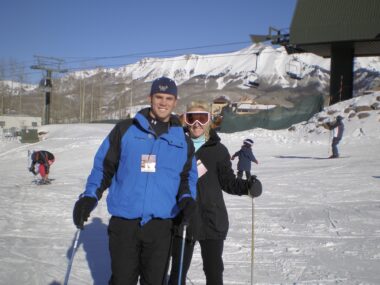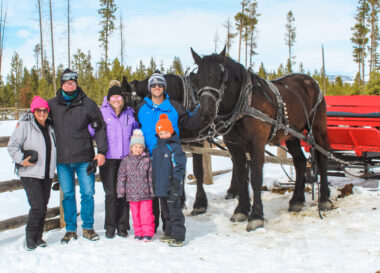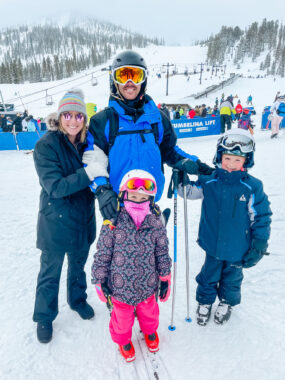What I learned during a family ski trip with Friedreich’s ataxia
A spring break vacation brought this columnist a new perspective

In 2006, when I was an 18-year-old senior in high school, I went skiing with my boyfriend, Kyle, and his family in Telluride, Colorado.
While we were there, Kyle and I talked about how fun it would be to take our hypothetical kids skiing one day. For as long as I can remember, I’ve loved traveling, and the idea of seeing the world through the eyes of my future children was so exciting. The thrill of doing something athletic and challenging made a future family ski trip seem like a Top 10 bucket list adventure.

Kendall and Kyle ski in Telluride, Colorado, in 2006. (Courtesy of Kendall Harvey)
Kyle is now my husband, and together we have an 8-year-old son, Brooks, and a 5-year-old daughter, Collins. This month, we traveled with my parents to Colorado for spring break. After a lot of research, we decided that lessons with a private instructor on Monarch Mountain would be an excellent introduction to skiing for our kids.
Because of the stage of my Friedreich’s ataxia (FA) symptoms, which began presenting when I was 25 years old, I couldn’t safely ski without adaptive equipment and skilled assistance. I wanted Kyle to be focused entirely on the kids’ safety and experience, so I chose to forgo participating in skiing. It absolutely gutted me, and I hated just sitting there and watching the action, but I believe it was the correct decision for the benefit of my kids.
True to form, my kids were troopers. Collins loved riding on the little magic carpet conveyor belt up to the top of the bunny slope where ski school took place. She was determined to try her best, and she had such a great attitude about skiing. Brooks was an instant expert. After only three hours, he was going down blue runs and tackling obstacles and jumps.
I was so proud of their resilience and attitude. But I’m ashamed to admit that I kept finding myself feeling envious of their athleticism and abilities.
I’d never wish my disabilities on anyone, especially my children, so I try to change my perspective when I fall into an envious train of thought. I put myself in my kids’ shoes to remember how I felt skiing at their ages — the challenge, pride, frustration, thrill, fear, accomplishment, uncertainty, and joy involved. I didn’t want to burden their tiny shoulders with my negative feelings on top of all that.

Kendall and her family in Monarch and Winter Park, Colorado, in 2023. (Courtesy of Kendall Harvey)
As my FA symptoms have become more unavoidable and debilitating over the past decade, I’ve been forced to build my life around my abilities, or lack thereof. Fortunately, I’m very safe and comfortable in my home. But when I travel, I don’t have my accessible house with ramps and wide door frames. My shower, bed, and toilets aren’t equipped with the grab rails and other safety measures that I’ve come to depend on. This leads to an increased dependence on others and, therefore, an increase in my baseline frustration level.
I tried to remind myself that I was already in a triggered state, being away from the accommodations of home, and that I needed to give myself grace. I tried telling myself that I wasn’t as much of a burden as I thought, and that my kind and compassionate family was happy to help me be a part of the trip. I tried to be an enthusiastic, encouraging, helpful, and involved spectator. No, I wasn’t able to help teach skiing, hold my kids’ hands on chairlifts, carry their snow tubes, or lug around suitcases, but I could zip jackets, hold hot chocolate, laugh when they threw snowballs, snuggle cold kids, buy souvenirs, and cheer everyone on!
All in all, I think I probably learned as much as my kids did this spring break. They learned a new skill that they’ll hopefully enjoy for a lifetime, and I learned more about a perspective that will help me enjoy my lifetime, come what may.

Kendall and her family ski in Monarch and Winter Park, Colorado, in 2023. (Courtesy of Kendall Harvey)
“Don’t copy the behavior and customs of this world, but let God transform you into a new person by changing the way you think. Then you will learn to know God’s will for you, which is good and pleasing and perfect.” — Romans 12:2 (NLT)
Note: Friedreich’s Ataxia News is strictly a news and information website about the disease. It does not provide medical advice, diagnosis, or treatment. This content is not intended to be a substitute for professional medical advice, diagnosis, or treatment. Always seek the advice of your physician or another qualified health provider with any questions you may have regarding a medical condition. Never disregard professional medical advice or delay in seeking it because of something you have read on this website. The opinions expressed in this column are not those of Friedreich’s Ataxia News or its parent company, Bionews, and are intended to spark discussion about issues pertaining to Friedreich’s ataxia.








Leave a comment
Fill in the required fields to post. Your email address will not be published.